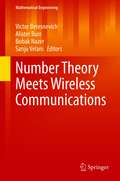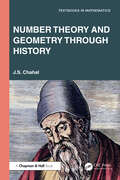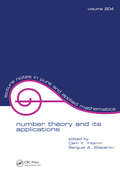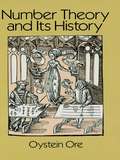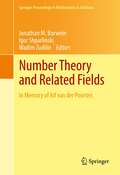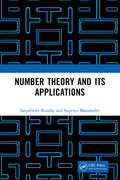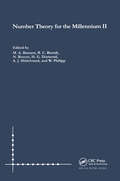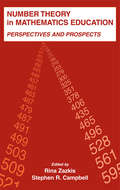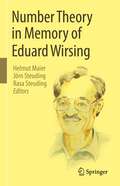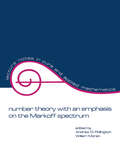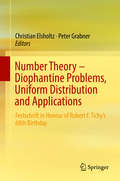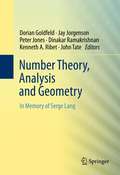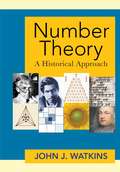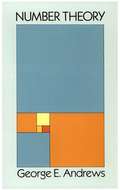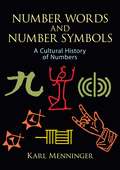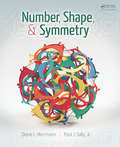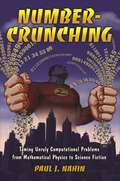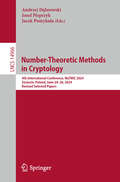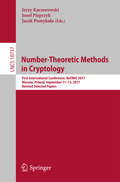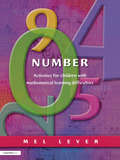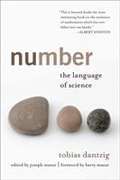- Table View
- List View
Number Theory Meets Wireless Communications (Mathematical Engineering)
by Alister Burr Victor Beresnevich Bobak Nazer Sanju VelaniThis volume explores the rich interplay between number theory and wireless communications, reviewing the surprisingly deep connections between these fields and presenting new research directions to inspire future research. The contributions of this volume stem from the Workshop on Interactions between Number Theory and Wireless Communication held at the University of York in 2016. The chapters, written by leading experts in their respective fields, provide direct overviews of highly exciting current research developments. The topics discussed include metric Diophantine approximation, geometry of numbers, homogeneous dynamics, algebraic lattices and codes, network and channel coding, and interference alignment. The book is edited by experts working in number theory and communication theory. It thus provides unique insight into key concepts, cutting-edge results, and modern techniques that play an essential role in contemporary research. Great effort has been made to present the material in a manner that is accessible to new researchers, including PhD students. The book will also be essential reading for established researchers working in number theory or wireless communications looking to broaden their outlook and contribute to this emerging interdisciplinary area.
Number Theory and Geometry through History (Textbooks in Mathematics)
by J. S. ChahalThis is a unique book that teaches mathematics and its history simultaneously. Developed from a course on the history of mathematics, this book is aimed at mathematics teachers who need to learn more about mathematics than its history, and in a way they can communicate it to middle and high school students. The author hopes to overcome, through the teachers using this book, math phobia among these students.Number Theory and Geometry through History develops an appreciation of mathematics by not only looking at the work of individual, including Euclid, Euler, Gauss, and more, but also how mathematics developed from ancient civilizations. Brahmins (Hindu priests) devised our current decimal number system now adopted throughout the world. The concept of limit, which is what calculus is all about, was not alien to ancient civilizations as Archimedes used a method similar to the Riemann sums to compute the surface area and volume of the sphere.No theorem here is cited in a proof that has not been proved earlier in the book. There are some exceptions when it comes to the frontier of current research.Appreciating mathematics requires more than thoughtlessly reciting first the ten by ten, then twenty by twenty multiplication tables. Many find this approach fails to develop an appreciation for the subject. The author was once one of those students. Here he exposes how he found joy in studying mathematics, and how he developed a lifelong interest in it he hopes to share.The book is suitable for high school teachers as a textbook for undergraduate students and their instructors. It is a fun text for advanced readership interested in mathematics.
Number Theory and Its Applications
by Cem Y. Yıldırım Serguei A. StepanovThis valuable reference addresses the methods leading to contemporary developments in number theory and coding theory, originally presented as lectures at a summer school held at Bilkent University, Ankara, Turkey.
Number Theory and Its History
by Oystein OreUnusually clear, accessible introduction covers counting, properties of numbers, prime numbers, Aliquot parts, Diophantine problems, congruences, much more. Bibliography.
Number Theory and Related Fields
by Igor Shparlinski Wadim Zudilin Jonathan M. Borwein"Number Theory and Related Fields" collects contributions based on the proceedings of the "International Number Theory Conference in Memory of Alf van der Poorten," hosted by CARMA and held March 12-16th 2012 at the University of Newcastle, Australia. The purpose of the conference was to promote number theory research in Australia while commemorating the legacy of Alf van der Poorten, who had written over 170 papers on the topic of number theory and collaborated with dozens of researchers. The research articles and surveys presented in this book were written by some of the most distinguished mathematicians in the field of number theory, and articles will include related topics that focus on the various research interests of Dr. van der Poorten.
Number Theory and its Applications
by Satyabrota Kundu Supriyo MazumderNumber Theory and its Applications is a textbook for students pursuing mathematics as major in undergraduate and postgraduate courses. Please note: Taylor & Francis does not sell or distribute the print book in India, Pakistan, Nepal, Bhutan, Bangladesh and Sri Lanka.
Number Theory for the Millennium II
by M. A. Bennett N. Boston H. G. Diamond A. J. Hildebrand B. C. Berndt W PhilippBuilding on the tradition of an outstanding series of conferences at the University of Illinois at Urbana-Champaign, the organizers attracted an international group of scholars to open the new Millennium with a conference that reviewed the current state of number theory research and pointed to future directions in the field. The conference was the largest general number theory conference in recent history, featuring a total of 159 talks, with the plenary lectures given by George Andrews, Jean Bourgain, Kevin Ford, Ron Graham, Andrew Granville, Roger Heath-Brown, Christopher Hooley, Winnie Li, Kumar Murty, Mel Nathanson, Ken Ono, Carl Pomerance, Bjorn Poonen, Wolfgang Schmidt, Chris Skinner, K. Soundararajan, Robert Tijdeman, Robert Vaughan, and Hugh Williams. The Proceedings Volumes of the conference review some of the major number theory achievements of this century and to chart some of the directions in which the subject will be heading during the new century. These volumes will serve as a useful reference to researchers in the area and an introduction to topics of current interest in number theory for a general audience in mathematics.
Number Theory in Mathematics Education: Perspectives and Prospects (Studies in Mathematical Thinking and Learning Series)
by Rina Zazkis Stephen R. CampbellThis book offers multiple interconnected perspectives on the largely untapped potential of elementary number theory for mathematics education: its formal and cognitive nature, its relation to arithmetic and algebra, its accessibility, its utility and intrinsic merits, to name just a few. Its purpose is to promote explication and critical dialogue about these issues within the international mathematics education community. The studies comprise a variety of pedagogical and research orientations by an international group of researchers that, collectively, make a compelling case for the relevance and importance of number theory in mathematics education in both pre K-16 settings and mathematics teacher education.Topics variously engaged include:*understanding particular concepts related to numerical structure and number theory;*elaborating on the historical and psychological relevance of number theory in concept development;*attaining a smooth transition and extension from pattern recognition to formative principles;*appreciating the aesthetics of number structure;*exploring its suitability in terms of making connections leading to aha! insights and reaching toward the learner's affective domain;*reexamining previously constructed knowledge from a novel angle;*investigating connections between technique and theory;*utilizing computers and calculators as pedagogical tools; and*generally illuminating the role number theory concepts could play in developing mathematical knowledge and reasoning in students and teachers.Overall, the chapters of this book highlight number theory-related topics as a stepping-stone from arithmetic toward generalization and algebraic formalism, and as a means for providing intuitively grounded meanings of numbers, variables, functions, and proofs.Number Theory in Mathematics Education: Perspectives and Prospects is of interest to researchers, teacher educators, and students in the field of mathematics education, and is well suited as a text for upper-level mathematics education courses.
Number Theory in Memory of Eduard Wirsing
by Helmut Maier Jörn Steuding Rasa SteudingEduard Wirsing was an outstanding number theorist. In his research he made significant contributions to various subfields of number theory and also collaborated with other eminent scientists (e.g., with the Fields Medalist Alan Baker as well as Don Zagier). This commemorative volume includes numerous papers on current research in number theory by well-known experts, as well as some personal recollections by companions of Wirsing. The topics covered in this volume include arithmetical functions, continued fractions, elementary proofs of the prime number theorem, friable integers, the Goldbach problem, Dirichlet series, Euler products, and more. There is something for every interested reader.
Number Theory with Computations (Springer Undergraduate Mathematics Series)
by Peter ShiuThis introductory text is designed for undergraduate courses in number theory, covering both elementary number theory and analytic number theory. The book emphasises computational aspects, including algorithms and their implementation in Python. The book is divided into two parts. The first part, on elementary number theory, deals with concepts such as induction, divisibility, congruences, primitive roots, cryptography, and continued fractions. The second part is devoted to analytic number theory and includes chapters on Dirichlet’s theorem on primes in arithmetic progressions, the prime number theorem, smooth numbers, and the famous circle method of Hardy and Littlewood. The book contains many topics not often found in introductory textbooks, such as Aubry’s theorem, the Tonelli–Shanks algorithm, factorisation methods, continued fraction representations of e, and the irrationality of 𝜁(3). Each chapter concludes with a summary and notes, as well as numerous exercises. Assuming only basic calculus for the first part of the book, the second part assumes some knowledge of complex analysis. Familiarity with basic coding syntax will be helpful for the computational exercises.
Number Theory with an Emphasis on the Markoff Spectrum (Lecture Notes In Pure And Applied Mathematics Ser. #147)
by William Moran Andrew D. PollingtonPresenting the proceedings of a recently held conference in Provo, Utah, this reference provides original research articles in several different areas of number theory, highlighting the Markoff spectrum.;Detailing the integration of geometric, algebraic, analytic and arithmetic ideas, Number Theory with an Emphasis on the Markoff Spectrum contains refereed contributions on: general problems of diophantine approximation; quadratic forms and their connections with automorphic forms; the modular group and its subgroups; continued fractions; hyperbolic geometry; and the lower part of the Markoff spectrum.;Written by over 30 authorities in the field, this book should be a useful resource for research mathematicians in harmonic analysis, number theory algebra, geometry and probability and graduate students in these disciplines.
Number Theory – Diophantine Problems, Uniform Distribution and Applications
by Christian Elsholtz Peter GrabnerThis volume is dedicated to Robert F. Tichy on the occasion of his 60th birthday. Presenting 22 research and survey papers written by leading experts in their respective fields, it focuses on areas that align with Tichy's research interests and which he significantly shaped, including Diophantine problems, asymptotic counting, uniform distribution and discrepancy of sequences (in theory and application), dynamical systems, prime numbers, and actuarial mathematics. Offering valuable insights into recent developments in these areas, the book will be of interest to researchers and graduate students engaged in number theory and its applications.
Number Theory, Analysis and Geometry
by Jay Jorgenson Dorian Goldfeld Dinakar Ramakrishnan John Tate Peter Jones Kenneth RibetSerge Lang was an iconic figure in mathematics, both for his own important work and for the indelible impact he left on the field of mathematics, on his students, and on his colleagues. Over the course of his career, Lang traversed a tremendous amount of mathematical ground. As he moved from subject to subject, he found analogies that led to important questions in such areas as number theory, arithmetic geometry, and the theory of negatively curved spaces. Lang's conjectures will keep many mathematicians occupied far into the future. In the spirit of Lang's vast contribution to mathematics, this memorial volume contains articles by prominent mathematicians in a variety of areas of the field, namely Number Theory, Analysis, and Geometry, representing Lang's own breadth of interest and impact. A special introduction by John Tate includes a brief and fascinating account of the Serge Lang's life. This volume's group of 6 editors are also highly prominent mathematicians and were close to Serge Lang, both academically and personally. The volume is suitable to research mathematicians in the areas of Number Theory, Analysis, and Geometry.
Number Theory, Fourier Analysis and Geometric Discrepancy
by Giancarlo TravagliniThe study of geometric discrepancy, which provides a framework for quantifying the quality of a distribution of a finite set of points, has experienced significant growth in recent decades. This book provides a self-contained course in number theory, Fourier analysis and geometric discrepancy theory, and the relations between them, at the advanced undergraduate or beginning graduate level. It starts as a traditional course in elementary number theory, and introduces the reader to subsequent material on uniform distribution of infinite sequences, and discrepancy of finite sequences. Both modern and classical aspects of the theory are discussed, such as Weyl's criterion, Benford's law, the Koksma–Hlawka inequality, lattice point problems, and irregularities of distribution for convex bodies. Fourier analysis also features prominently, for which the theory is developed in parallel, including topics such as convergence of Fourier series, one-sided trigonometric approximation, the Poisson summation formula, exponential sums, decay of Fourier transforms, and Bessel functions.
Number Theory: A Historical Approach
by John J. Watkins<p>The natural numbers have been studied for thousands of years, yet most undergraduate textbooks present number theory as a long list of theorems with little mention of how these results were discovered or why they are important. This book emphasizes the historical development of number theory, describing methods, theorems, and proofs in the contexts in which they originated, and providing an accessible introduction to one of the most fascinating subjects in mathematics. <p>Written in an informal style by an award-winning teacher, Number Theory covers prime numbers, Fibonacci numbers, and a host of other essential topics in number theory, while also telling the stories of the great mathematicians behind these developments, including Euclid, Carl Friedrich Gauss, and Sophie Germain. This one-of-a-kind introductory textbook features an extensive set of problems that enable students to actively reinforce and extend their understanding of the material, as well as fully worked solutions for many of these problems. It also includes helpful hints for when students are unsure of how to get started on a given problem. <p> <li>Uses a unique historical approach to teaching number theory <li>Features numerous problems, helpful hints, and fully worked solutions <li>Discusses fun topics like Pythagorean tuning in music, Sudoku puzzles, and arithmetic progressions of primes <li>Includes an introduction to Sage, an easy-to-learn yet powerful open-source mathematics software package <li>Ideal for undergraduate mathematics majors as well as non-math majors <li>Digital solutions manual (available only to professors)</li> </p>
Number Theory: An Introduction to Pure and Applied Mathematics (Chapman And Hall/crc Pure And Applied Mathematics Ser. #201)
by Don RedmondThis text provides a detailed introduction to number theory, demonstrating how other areas of mathematics enter into the study of the properties of natural numbers. It contains problem sets within each section and at the end of each chapter to reinforce essential concepts, and includes up-to-date information on divisibility problems, polynomial congruence, the sums of squares and trigonometric sums.;Five or more copies may be ordered by college or university bookstores at a special price, available on application.
Number Theory: The Theory Of Partitions (Dover Books on Mathematics #Vol. 2)
by George E. AndrewsAlthough mathematics majors are usually conversant with number theory by the time they have completed a course in abstract algebra, other undergraduates, especially those in education and the liberal arts, often need a more basic introduction to the topic.In this book the author solves the problem of maintaining the interest of students at both levels by offering a combinatorial approach to elementary number theory. In studying number theory from such a perspective, mathematics majors are spared repetition and provided with new insights, while other students benefit from the consequent simplicity of the proofs for many theorems.Among the topics covered in this accessible, carefully designed introduction are multiplicativity-divisibility, including the fundamental theorem of arithmetic, combinatorial and computational number theory, congruences, arithmetic functions, primitive roots and prime numbers. Later chapters offer lucid treatments of quadratic congruences, additivity (including partition theory) and geometric number theory.Of particular importance in this text is the author's emphasis on the value of numerical examples in number theory and the role of computers in obtaining such examples. Exercises provide opportunities for constructing numerical tables with or without a computer. Students can then derive conjectures from such numerical tables, after which relevant theorems will seem natural and well-motivated..
Number Words and Number Symbols: A Cultural History of Numbers
by Karl MenningerThis book is not only a fascinating introduction to the concept of number and to numbers themselves, hut a multifaceted linguistic and historical analysis of how numbers have developed and evolved in many different cultures. Drawing on evidence from history, literature, philosophy and ethnology, noted German scholar Karl Menninger. recounts the development of numbers both as they are spoken (and written as words) and as symbolic abstract numerals that can he readily manipulated and combined.Despite the immense erudition the author brings to the topic, he maintains a light tone throughout, presenting much of the information in anecdotal form. Moreover, almost 300 illustrations (photographs and drawings) and many comparative language tables serve to enhance the text. The author begins with a lucid treatment of number sequence and number language, including the formation of number words in both Indo-European and non-IndoEuropean languages, hidden number words and the evolution of the number sequence. He then turns to written numerals and computations: finger counting, folk symbols for numbers, alphabetical numerals, the "German" Roman numerals, the abacus and more. The final section concerns the development of our modem decimal system, with its place notation and zero, based on the Indian number system, and its introduction to the West through the work of the Italian mathematician Fibonacci. The author concludes with a review of spoken numbers and number symbols in China and Japan.
Number, Shape, & Symmetry: An Introduction to Number Theory, Geometry, and Group Theory
by Diane L. Herrmann Paul J. Sally Jr.Through a careful treatment of number theory and geometry, Number, Shape, & Symmetry: An Introduction to Number Theory, Geometry, and Group Theory helps readers understand serious mathematical ideas and proofs. Classroom-tested, the book draws on the authors' successful work with undergraduate students at the University of Chicago, seventh
Number-Crunching: Taming Unruly Computational Problems from Mathematical Physics to Science Fiction
by Paul J. NahinMore stimulating mathematics puzzles from bestselling author Paul NahinHow do technicians repair broken communications cables at the bottom of the ocean without actually seeing them? What's the likelihood of plucking a needle out of a haystack the size of the Earth? And is it possible to use computers to create a universal library of everything ever written or every photo ever taken? These are just some of the intriguing questions that best-selling popular math writer Paul Nahin tackles in Number-Crunching. Through brilliant math ideas and entertaining stories, Nahin demonstrates how odd and unusual math problems can be solved by bringing together basic physics ideas and today's powerful computers. Some of the outcomes discussed are so counterintuitive they will leave readers astonished.Nahin looks at how the art of number-crunching has changed since the advent of computers, and how high-speed technology helps to solve fascinating conundrums such as the three-body, Monte Carlo, leapfrog, and gambler's ruin problems. Along the way, Nahin traverses topics that include algebra, trigonometry, geometry, calculus, number theory, differential equations, Fourier series, electronics, and computers in science fiction. He gives historical background for the problems presented, offers many examples and numerous challenges, supplies MATLAB codes for all the theories discussed, and includes detailed and complete solutions.Exploring the intimate relationship between mathematics, physics, and the tremendous power of modern computers, Number-Crunching will appeal to anyone interested in understanding how these three important fields join forces to solve today's thorniest puzzles.
Number-Theoretic Methods in Cryptology: 4th International Conference, NuTMiC 2024, Szczecin, Poland, June 24–26, 2024, Revised Selected Papers (Lecture Notes in Computer Science #14966)
by Josef Pieprzyk Jacek Pomykała Andrzej DąbrowskiThis book constitutes the refereed post-conference proceedings of the 4th International Conference on Number-Theoretic Methods in Cryptology, NuTMiC 2024, held in Szczecin, Poland, during June 24–26, 2024.The 9 full papers and 2 invited papers presented in this book were carefully reviewed and selected from 12 submissions. They were organized in topical sections as follows: invited talks; elliptic curves in cryptography; number theory; algebraic structures and public-key cryptography.
Number-Theoretic Methods in Cryptology: First International Conference, Nutmic 2017, Warsaw, Poland, September 11-13, 2017, Revised Selected Papers (Lecture Notes in Computer Science #10737)
by Josef Pieprzyk Jerzy Kaczorowski Jacek PomykałaThis book constitutes the refereed post-conference proceedings of the First International Conference on Number-Theoretic Methods in Cryptology, NuTMiC 2017, held in Warsaw, Poland, in September 2017.The 15 revised full papers presented in this book together with 3 invited talks were carefully reviewed and selected from 32 initial submissions. The papers are organized in topical sections on elliptic curves in cryptography; public-key cryptography; lattices in cryptography; number theory; pseudorandomness; and algebraic structures and analysis.
Number: Activities for Children with Mathematical Learning Difficulties
by Mel LeverFirst Published in 2003. Routledge is an imprint of Taylor & Francis, an informa company.
Number: The Language of Science
by Tobias DantzigNumber is an eloquent, accessible tour de force that reveals how the concept of number evolved from prehistoric times through the twentieth century. Renowned professor of mathematics Tobias Dantzig shows that the development of math—from the invention of counting to the discovery of infinity—is a profoundly human story that progressed by “trying and erring, by groping and stumbling.” He shows how commerce, war, and religion led to advances in math, and he recounts the stories of individuals whose breakthroughs expanded the concept of number and created the mathematics that we know today.
Numbers
by Paul ThurlbyAn incredibly stylish numbers book - perfect for children and adults alike.Have fun with numbers with an award-winning illustrator. Paul creates an amazing world where each number becomes its word. From '3 for 3D' and '5 for high five' to '10 for a perfect 10', each number is familiar, yet unique. Praise for Alphabet: 'Skilfully constructed and cleverley composed, it's an awesome alphabet book that adults will also appreciate.' Kirkus Reviews'Paul Thurlby's prints are so ludicrously beautiful that I am seriously tempted to blow the budget, order the whole lot and paper a wall with them.' India Knight, journalist and author
